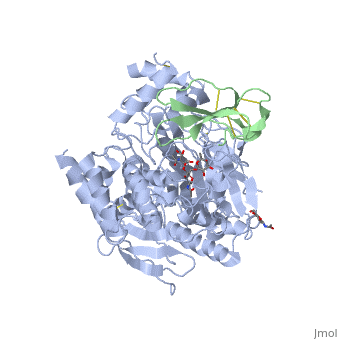Cholinesterase
From Proteopedia
Cholinesterase belong to the serine hydrolase family of proteins. They catalyze the hydrolysis of the neurotransmitter acetylcholine into choline and acetic acid, a reaction necessary to allow a cholinergic neuron to return to its resting state after activation.
They are mainly of two types, namely acetylcholinesterase (AChE) and butyrylcholinesterase (BChE). AChE (EC 3.1.1.7), also known as RBC cholinesterase, erythrocyte cholinesterase, or (most formally) acetylcholine acetylhydrolase, found primarily in the blood and neural synapses. Acetylcholinesterase exists in multiple molecular forms. In the mammalian brain the majority of AChE occurs as a tetrameric, G4 form with much smaller amounts of a monomeric G1 (4S) form.
==Your Heading Here (maybe something like 'Structure')==
| |||||||||||
Pseudocholinesterase (BChE or BuChE), also known as plasma cholinesterase, butyrylcholinesterase, or (most formally) acylcholine acylhydrolase, found primarily in the liver.
The difference between the two types of cholinesterase has to do with their respective preferences for substrates: the former hydrolyses acetylcholine more quickly; the latter hydrolyses butyrylcholine more quickly.
INFORMATION PROVIDED HERE ARE NOT EXHAUSTIVE; REMAINS TO BE UPDATED
Proteopedia Page Contributors and Editors (what is this?)
Michal Harel, Joel L. Sussman, Lakshmi Venkatachalam, Alexander Berchansky

